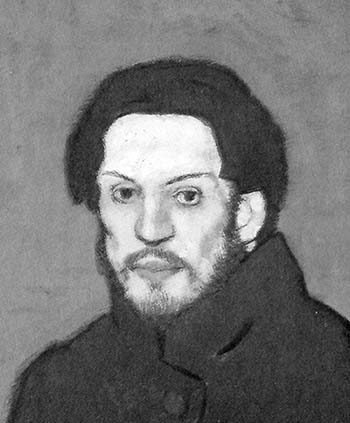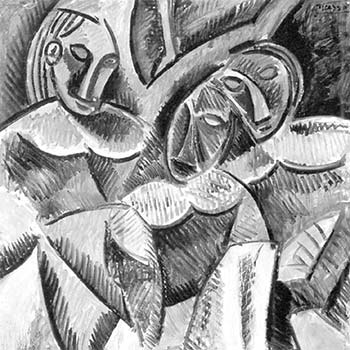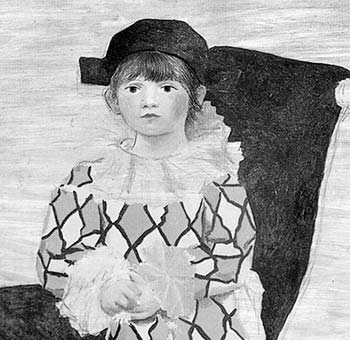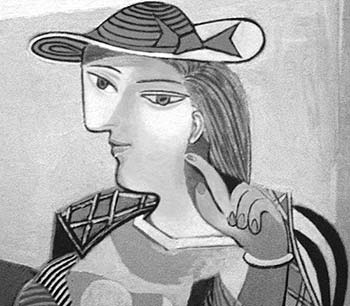
Musée Picasso
The 20th century’s most famous and—OK, I’ll say it—greatest artist was the master of many styles (Cubism, Surrealism, Expressionism, etc.) and of many media (painting, sculpture, prints, ceramics, and assemblages). Still, he could make anything he touched look unmistakably like “a Picasso.”
The Picasso Museum has over 400 of his works, showing the whole range of the artist’s long life and many styles. The women he loved and the global events he lived through appear in his canvases, filtered through his own emotional lens. You don’t have to admire Picasso’s lifestyle or like his modern painting style. But a visit here might make you appreciate the sheer vitality and creativity of this hardworking and unique man.
The core of the museum is organized chronologically—and so is this chapter. Since the collection changes frequently, this is not a painting-by-painting tour. Rather, use the chapter to get an overview of Picasso’s life and some of the themes in his work.
Cost: €11, covered by Museum Pass, free on first Sun of month and for those under age 18 with ID.
Hours: Tue-Fri 11:30-18:00 (until 21:00 on third Fri of month), Sat-Sun 9:30-18:00, closed Mon, last entry 45 minutes before closing.
Avoiding Lines: Avoid ticket lines with either a Paris Museum Pass or by making a timed-entry reservation at www.musee-picasso.fr.
Avoiding Crowds: It’s busiest in the morning until 14:00, when crowds subside somewhat.
Getting There: 5 Rue de Thorigny, Mo: St. Paul or Chemin Vert (see Marais map on here).
Information: The museum has excellent posted information in English and a videoguide (€4). Tel. 01 42 71 25 21, www.musee-picasso.fr.
Length of This Tour: Allow one hour.
Photography: Permitted.
As you enter the museum courtyard, find the correct line: for ticket buyers (the longest line), for Paris Museum Pass holders, or for timed-entry reservations. After passing through security, you’ll see the ticket-buying and videoguide counters.
The museum has five floors. This chapter covers floors 0 to 2, what the museum calls the “Picasso Grand Tour.”
• Show your ticket and enter the first room on floor 0 (labeled “0.1”).
Born in Spain, Picasso was the son of an art teacher. As a teenager he quickly advanced beyond his teachers. He mastered camera-eye realism but also showed an empathy for the people he painted that was insightful beyond his years. (Unfortunately, the museum has few early works. Many doubters of Picasso’s genius warm to him somewhat after seeing his excellent draftsmanship and facility with oils from his youth.) As a teenager in Barcelona, he fell in with a bohemian crowd that mixed wine, women, and art.
In 1900, Picasso set out to make his mark in Paris, the undisputed world capital of culture. He rejected the surname his father had given him (Ruíz) and chose his mother’s instead, making it his distinctive one-word brand: Picasso.
The brash Spaniard quickly became a poor, homesick foreigner, absorbing the styles of many painters (especially Henri de Toulouse-Lautrec) while searching for his own artist’s voice. He found companionship among fellow freaks and outcasts on Butte Montmartre, painting jesters, circus performers, and garish cabarets. When his best friend committed suicide (look for the painting Death of Casagemas, 1901), Picasso plunged into a “Blue Period,” painting emaciated beggars, hard-eyed pimps, and himself, bundled up against the cold, with eyes all cried out (Autoportrait, 1901; see photo on here).
In 1904, Picasso moved into his Bateau-Lavoir home/studio on Montmartre (see Montmartre Walk, here), got a steady girlfriend, and suddenly saw the world through rose-colored glasses (the Rose Period, though the museum has very few works from this time).
Only 25 years old, Picasso reinvented painting. Fascinated by the primitive power of African and Iberian tribal masks, he sketched human faces with simple outlines and almond eyes (Autoportrait, 1906). Intrigued by the body of his girlfriend, Fernande Olivier, he sketched it from every angle (the museum has a few nude studies), then experimented with showing several different views on the same canvas.
A hundred paintings and nine months later, Picasso gave birth to a monstrous canvas of five nude, fragmented prostitutes with masklike faces—Les Demoiselles d’Avignon (1907). The painting hangs in New York’s Museum of Modern Art, but the Picasso Museum has some similar-looking primitive nudes. His friends were speechless over the bold new style, his enemies reviled it, and almost overnight, Picasso was famous.

Picasso went to the Louvre for a special exhibit on Cézanne, then returned to the Bateau-Lavoir to expand on Cézanne’s chunky style and geometric simplicity—oval-shaped heads, circular breasts, and diamond thighs. Picasso rejected traditional 3-D. Instead of painting, say, a distant hillside in dimmer tones than the trees in the bright foreground, Picasso did it all bright, making the foreground blend into the background and turning a scene into an abstract design. Modern art was being born.
With his next-door neighbor, Georges Braque, Picasso invented Cubism, a fragmented, “cube”-shaped style. He’d fracture a figure (such as the musician in Man with a Mandolin, 1911) into a barely recognizable jumble of facets, and facets within facets. Even empty space is composed of these “cubes,” all of them the same basic color, that weave together the background and foreground. Picasso sketches reality from every angle, then pastes it all together, a composite of different views. The monochrome color (mostly gray or brown) is less important than the experiments with putting the 3-D world on a 2-D canvas in a modern way. (For more on Cubism, see the Pompidou Center Tour, here.)
Picasso didn’t stop there. His first stage had been so-called Analytic Cubism (1910-1913): breaking the world down into small facets, to “analyze” the subject from every angle. Now it was time to “synthesize” it back together with the real world (Synthetic Cubism). He created “constructions” that were essentially still-life paintings (a 2-D illusion) augmented with glued-on, real-life materials—wood, paper, rope, or chair caning (the real 3-D world). The contrast between real objects and painted objects makes it clear that while traditional painting is a mere illusion, art can be more substantial.
In a few short years, Picasso had turned painting in the direction it would go for the next 50 years.
Personally, Picasso’s life had fragmented into a series of relationships with women. In 1917 he met and married a graceful Russian dancer with the Ballet Russes, Olga Kokhlova (Portrait of Olga in an Armchair, 1917).
Soon he was a financially secure husband and father (see the portrait of his three-year-old son, Paul en Harlequin, 1924). With the disastrous Great War over, Picasso took his family for summer vacations on the Riviera. There, he painted peaceful scenes of women and children at the beach.

A trip to Rome inspired him to emulate the bulky mass of ancient statues, transforming them into plump but graceful women, with Olga’s round features. Picasso could create the illusion of a face or body bulging out from the canvas, like a cameo or classical bas-relief. Watching kids drawing in the sand with a stick, he tried drawing a figure without lifting the brush from the canvas.
After World War I, Picasso moved from Montmartre to the Montparnasse neighborhood. Over the years, Picasso had 13 different studios in Paris, mainly in Montmartre or Montparnasse.
In 1927, a middle-aged Picasso stopped a 17-year-old girl outside the Galeries Lafayette department store (by the Opéra Garnier) and said, “Mademoiselle, you have an interesting face. Can I paint it? I am Picasso.” She said, “Who?”
The two had little in common, but the unsophisticated Marie-Thérèse Walter and the short, balding artist developed a strange attraction for each other. Soon, Marie-Thérèse moved into the house next door to Picasso and his wife, and they began an awkward three-wheeled relationship. Worldly Olga was jealous, young Marie-Thérèse was insecure and clingy, and Picasso was a workaholic artist who faithfully chronicled the erotic/neurotic experience in canvases of twisted, screaming nudes.

Europe was gearing up for war. From Paris, Picasso watched as his homeland of Spain erupted in a brutal civil war (1936-1939), in which a half-million of his countrymen died. Many canvases from this period are gray and gloomy. The most famous of Picasso’s gray-colored war paintings—Guernica (1937)—captured the chaos of a Spanish village caught in an air raid. The Picasso Museum has some of the many studies he did for this monumental canvas, employing typical Spanish imagery—bulls, screaming horses, a Madonna. The work summed up the heartache of Spain and foreshadowed the onslaught of World War II. After 1936, Picasso vowed to never again set foot in fascist-controlled Spain, and he never did.
• Go upstairs to floor 2.
The Spaniard lived almost all of his adult life in France, but he remained a Spaniard at heart, incorporating Spanish motifs into his work.
Unrepentantly macho, he loved bullfights, seeing them as a metaphor for the timeless human interaction between the genders. Me bull, you horse, I gore you.
The Minotaur (a bull-headed man) symbolized man’s warring halves: half rational human (Freud’s superego) and half raging beast (the id). Picasso could be both tender and violent with women, thus playing out both sides of this love/war duality.
In 1940, Nazi tanks rolled into Paris. Picasso decided to stay for the duration and live under gray skies and gray uniforms—painting many gray canvases. Not only did he suffer from wartime shortages, condescending Nazis, and the grief of having comrades killed or deported, he had girl trouble. “The worst time of my life,” he said. His beloved mother had died, and he endured the endless, bitter divorce from Olga, all the while juggling his two longtime, feuding mistresses—as well as the occasional fling.
After the pain of the war years, it was time for a change.
Sun! Color! Water! Spacious skies! Freedom!
At war’s end, Picasso left Paris and all that emotional baggage behind, finding fun in the sun in the south of France. Sixty-five-year-old Pablo Picasso was reborn, enjoying worldwide fame and the love of a beautiful 23-year-old painter named Françoise Gilot. She soon offered him a fresh start at fatherhood, giving birth to son Claude and daughter Paloma.
Picasso spent mornings swimming in the Mediterranean, days painting, evenings partying with friends, and late nights painting again, like a madman. Dressed in rolled-up white pants and a striped sailor’s shirt, bursting with pent-up creativity, he often cranked out more than a painting a day. Ever-restless Picasso had finally found his Garden of Eden and rediscovered his joie de vivre.
He palled around with Henri Matisse, his rival for the title of Century’s Greatest Painter. Occasionally they traded masterpieces, letting the other pick out his favorite for his own collection.
Picasso’s Riviera works set the tone for the rest of his life—sunny, light-hearted, childlike, experimenting in new media, and using motifs of the sea, Greek mythology (fauns, centaurs), and animals (birds, goats, and pregnant baboons). His childlike doves became an international symbol of peace. These joyous themes announce Picasso’s newfound freedom in a newly liberated France.
Picasso was fertile to the end, still painting with bright thick colors at age 91. With no living peers in the world of art, the great Picasso dialogued with dead masters, reworking paintings by Edouard Manet, Diego de Velázquez, and others. Oh yes, also in this period he met mistress number...um, whatever: 27-year-old Jacqueline Roque, whom he later married.
Throughout his long life, Picasso was intrigued by portraying people—always people, ignoring the background—conveying their features with a single curved line and their moods with colors. These last works have the humor and playfulness of someone much younger. As it has been said of Picasso, “When he was a child, he painted like a man. When he was old, he painted like a child.”
There’s plenty more Picasso on the other two floors. The paintings are just as good as what we’ve seen, but they’re organized differently.
The third floor has Picasso’s private collection of works by painters he admired—Cézanne, his compatriot Braque, and more. Curators have cleverly interspersed these with Picasso’s own works, showing how he was inspired by them.
Level -1 is called “The Studios.” Each room on this level has works created in the studios where Picasso worked on Montmartre, in Montparnasse, and elsewhere in Paris, along with photos of the studios. The most famous of the studios were Le Bateau-Lavoir (Room -1.1; see here of the Montmartre Walk chapter) and the Left Bank space where he created Guernica (Room -1.3), chronicled here with photographs by Dora Maar.